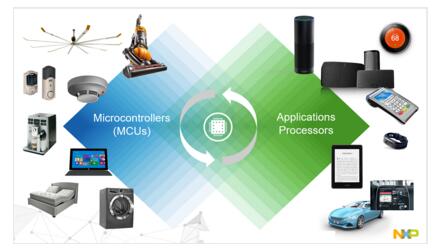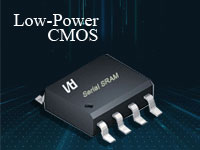NXP to Bridge MCU & AP with 'Crossovers'
To use an MCU or not (and to opt for an apps processor instead)? This is an eternal question for embedded system designers, and one that NXP Semiconductors hopes to answer by launching a new high-end MCU.
MADISON, Wis. — To use an MCU or not (and to opt for an apps processor instead)? This is an eternal question for embedded system designers, and one that NXP Semiconductors hopes to answer by launching a new high-end MCU.
NXP believes that its ARM Cortex-M7-based processor, the i.MX RT series, will fill the cost and real-time deterministic operations gaps in applications processing. It will also solve issues microcontrollers have not yet been able to address — higher performance and richer user interfaces. NXP calls it a “crossover processor.”
Not everyone in the analyst community is entirely sold on this “crossover” idea, since the lines between MCUs and apps processors (AP) are already blurring.
But NXP is sticking by its concept.
Geoff Lees, NXP’s senior vice president and general manager of microcontrollers, noted that his company is simply accelerating what’s already happening — the collapse of boundaries between apps processors and traditional MCUs. Insisting that the crossover processor will “bring the best of both worlds,” Lees said, “We have combined here the best attributes of apps processors like performance, high level of integration, and rich user experience with the ease-of-use and real-time deterministic operation of MCUs.”
More specifically, NXP’s crossover processor is “the highest performing ARM Cortex-M7 based device with real time operation and an applications processor-level of functionality,” according to the company. At 600MHz, it is 50 percent faster than any other Cortex-M7 product and more than twice as fast as existing Cortex-M4 products, the company said. The i.MX RT 1500 also offers an interrupt latency as low as 20 nanoseconds, which NXP claims as “the lowest among all ARM Cortex-based products in the world.”
Lees also made it clear that i.MX RT 1050 processor is only the beginning of a new-generation of faster-speed MCUs designed to be simpler to use. “I expect the GHz Cortex-M to come soon," he said. "I don’t see why not.”
Who will benefit?
So, what’s the target market for crossover processors? NXP believes everything from smart connected home appliances, healthcare devices to drones and factory automation equipment will benefit.
Lees observed, “IoT has put things on fire.” On one hand, traditional MCUs are designed with no wireless connectivity, display support, security or massive data processing in mind. However, compared to MCUs, apps processors remain much more costly and harder to program. IoT devices, in Lees’ opinion, have exposed embedded system designers’ needs that have been addressed neither by apps processors nor MCUs.

(Source: NXP)
“Whether it is an edge node with a single function, a combination device or a home gateway unit, embedded system designers need a solution that can let them add IoT capabilities without drastically increasing per-unit cost,” Lees explained.
Asked about potential target products of NXP’s crossovers, Jim McGregor, principal analyst at Tirias Research, said, “I can see this for something like industrial automation, robotic control, and other applications that are slowly migrating up the performance stack or a low-end control application that requires a graphics applications.”
McGregor says crossover processors can give designers “the flexibility of an applications processor configuration (graphics, I/O, etc.) with the power consumption of an MCU.” He added, “You can also run embedded OSs on it. So, it's perfect for those embedded applications that don't want or need to step up to a full applications processor.”
How quickly is a crossover processor market likely to grow?
McGregor cautioned that the embedded market does not move quickly. “If someone is looking at this today, you can expect a design and production in a few years. Expect slow growth with a product like this.”
Crossover of what?
Some analysts steeped in the MCU/apps processor technology landscape find the “crossover” label either confusing or plain wrong.
MADISON, Wis. — To use an MCU or not (and to opt for an apps processor instead)? This is an eternal question for embedded system designers, and one that NXP Semiconductors hopes to answer by launching a new high-end MCU.
NXP believes that its ARM Cortex-M7-based processor, the i.MX RT series, will fill the cost and real-time deterministic operations gaps in applications processing. It will also solve issues microcontrollers have not yet been able to address — higher performance and richer user interfaces. NXP calls it a “crossover processor.”
Not everyone in the analyst community is entirely sold on this “crossover” idea, since the lines between MCUs and apps processors (AP) are already blurring.
But NXP is sticking by its concept.
Geoff Lees, NXP’s senior vice president and general manager of microcontrollers, noted that his company is simply accelerating what’s already happening — the collapse of boundaries between apps processors and traditional MCUs. Insisting that the crossover processor will “bring the best of both worlds,” Lees said, “We have combined here the best attributes of apps processors like performance, high level of integration, and rich user experience with the ease-of-use and real-time deterministic operation of MCUs.”
More specifically, NXP’s crossover processor is “the highest performing ARM Cortex-M7 based device with real time operation and an applications processor-level of functionality,” according to the company. At 600MHz, it is 50 percent faster than any other Cortex-M7 product and more than twice as fast as existing Cortex-M4 products, the company said. The i.MX RT 1500 also offers an interrupt latency as low as 20 nanoseconds, which NXP claims as “the lowest among all ARM Cortex-based products in the world.”
Lees also made it clear that i.MX RT 1050 processor is only the beginning of a new-generation of faster-speed MCUs designed to be simpler to use. “I expect the GHz Cortex-M to come soon," he said. "I don’t see why not.”
Who will benefit?
So, what’s the target market for crossover processors? NXP believes everything from smart connected home appliances, healthcare devices to drones and factory automation equipment will benefit.
Lees observed, “IoT has put things on fire.” On one hand, traditional MCUs are designed with no wireless connectivity, display support, security or massive data processing in mind. However, compared to MCUs, apps processors remain much more costly and harder to program. IoT devices, in Lees’ opinion, have exposed embedded system designers’ needs that have been addressed neither by apps processors nor MCUs.

(Source: NXP)
“Whether it is an edge node with a single function, a combination device or a home gateway unit, embedded system designers need a solution that can let them add IoT capabilities without drastically increasing per-unit cost,” Lees explained.
Asked about potential target products of NXP’s crossovers, Jim McGregor, principal analyst at Tirias Research, said, “I can see this for something like industrial automation, robotic control, and other applications that are slowly migrating up the performance stack or a low-end control application that requires a graphics applications.”
McGregor says crossover processors can give designers “the flexibility of an applications processor configuration (graphics, I/O, etc.) with the power consumption of an MCU.” He added, “You can also run embedded OSs on it. So, it's perfect for those embedded applications that don't want or need to step up to a full applications processor.”
How quickly is a crossover processor market likely to grow?
McGregor cautioned that the embedded market does not move quickly. “If someone is looking at this today, you can expect a design and production in a few years. Expect slow growth with a product like this.”
Crossover of what?
Some analysts steeped in the MCU/apps processor technology landscape find the “crossover” label either confusing or plain wrong.
CONTACT US
USA
Vilsion Technology Inc.
36S 18th AVE Suite A,Brington,Colorado 80601,
United States
E-mail:sales@vilsion.com
Europe
Memeler Strasse 30 Haan,D 42781Germany
E-mail:sales@vilsion.com
Middle Eastern
Zarchin 10St.Raanana,43662 Israel
Zarchin 10St.Raanana,43662 Israel
E-mail:peter@vilsion.com
African
65 Oude Kaap, Estates Cnr, Elm & Poplar Streets
Dowerglen,1609 South Africa
E-mail:amy@vilsion.com
Asian
583 Orchard Road, #19-01 Forum,Singapore,
238884 Singapore
238884 Singapore
E-mail:steven@vilsion.com
